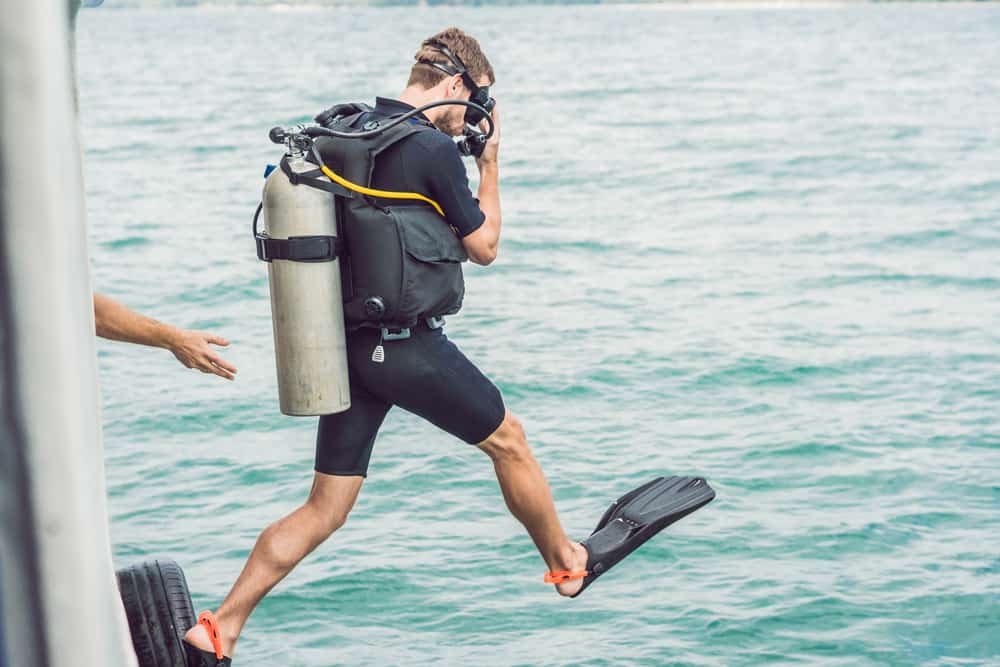Why do Scuba Divers Dive Backwards into the Water?
There are a number of methods to enter the water when you go diving. One of the most common ones is that scuba divers dive backwards into the water. That is only one of the ways to enter though and it is the one entry-method that is associated with an age-old joke though.
When wondering aloud why scuba divers fall backward into the water, novice divers often find themselves in the position of hearing an age-old joke. It goes something like this:
Divers roll backward into the water because if they rolled forward, they would fall into the boat.
Very funny…
But why do divers dive with their back first into the water? Why is it that a standard method of entering the water for scuba diving is that divers fall backward instead of head first? Couldn’t we fling our legs over the side of the boat and roll in face first? To be sure, the idea of looking into the water as we fall into it is more comfortable than to roll blindly backward.
Well, there are a few explanations. And, becoming familiar with the rationale will prevent new scuba divers from having to hear the humorous, if not very informative, joke about tumbling head-first into the deck.
Basics of the Backward Roll for Scuba Diving
First, though, let’s review the basics of the backward roll. You’re going to use this backward roll method to fall with your back first into the water only in boats that are less than three or four feet from the surface of the water.
Anything more than that and physics is going to get the best of you as you continue to roll. You enter the water tumbling too much and land with your head instead of your back. So, don’t use the backward roll as your diving method when you are on larger boats!
The backward roll also has the advantage that you start with a seated position. This lowers the center of gravity of the boat or platform reducing heavy rocking when you dive into the water.
Get your diving gear on
To get started, check your scuba diving gear and make sure all equipment is working. Verify that the batteries of your dive computer and other pieces of diving equipment are sufficiently full. You and your dive party are going to don all of the dive gear (Scuba Diving Gear List – The Complete Dive Equipment Guide) on the deck of the boat. Get ready for entry by sitting on the gunwale with your back to the water.
Where are your hands?
Once you’ve checked (and double-checked) that the area is clear behind you, place your right hand over your regulator (Scuba Regulator Buying Guide – What do you need to know!) to hold it in place while using your fingertips to stabilize your mask. Your left hand can keep any other loose hoses in place. You can use it to keep your facemask on, secure the strap at the back of your head, or stay at your side – Best Scuba Diving Masks – Reviews and Buying Advice.
Roll away!
When you’re ready, tuck your chin in towards your chest and fall back first into the water using the backward roll method. When you’ve made impact after your roll, give yourself a moment to get your bearings and then provide an okay signal to the crew on the boat. All said and done; it’s a simple and effective way to get into the water.

Why do so many Scuba Divers Dive Backwards?
Now, why exactly have so many divers adopted to fall backward off the boat and into the water? Here are a few reasons:
It helps you have control over your equipment
When you’re facing away from the water at first impact, you’re better able to shield your gear and keep a hold of your facemask and hoses. Scuba divers who try entering the other way usually end up with water in their mask, if they can keep their mask on that is (What Is Mask Squeeze and How to Prevent Facial Barotrauma). Suffice to say. It only takes one attempt at a forwards roll to realize it’s not a good idea.
Falling backward is easier on your body

Even if you’re only falling from a few feet, water can be a pretty unforgiving element. Falling forwards with a heavy scuba tank on your back can be an uncomfortable experience, to put it lightly.
You may also get a painful smack in the face from your mask as it collides with the surface. All in all, that’s not a preferred entry by any means and scuba divers fall backwards.
It stabilizes the boat
The backward roll is the best option for scuba divers when you’re in a small boat like a RIB (rigid inflatable boat). Such a small boat may have a low or less-than-sturdy gunwale, preventing you from standing on top and stepping into the water.
Another consideration for these smaller boats is the impact you can have stepping off of them. If your exit from the gunwale is going to cause the boat to rock dramatically, the backward roll minimizes the effect. For the safety of all aboard, you want to make sure that the boat does not rock to the point that it rolls over.
Alternative Entry Methods
As you can see, the backward roll is usually a pretty safe and reliable option for divers. Of course, there are a few alternatives, as well. Of the many methods available, the giant stride and the seated entry are probably the most well-known method of entry.
The giant stride
Requirements for the giant stride entry method for scuba divers are a stable platform like a pier, edge of a pool, or one that you would find on a dive boat, and deep, clear water. Get ready by gearing up and standing at the edge of the platform with your fins hanging over the edge.
Shearwater Teric vs. Suunto D5 vs. Garmin Descent Mk1 – Best Wrist Watch Dive Computer!

Some experts suggest inflating your BCD halfway to increase your buoyancy before diving into the water. When you’ve got a hand securely on your regulator and mask, you can do a final check that the water is clear and take a big step forward into the water off the boat.

You step out far enough so that your tank and other dive gear don’t accidentally hit the side of the boat on your way down. Hold on tight to your mask and regulator with your right hand when you enter so they won’t come off or get dislocated.
And that’s it! You’re ready to go! Don’t feel like you have to jump! Simply take a giant stride and plunge into the water.
You’ll enter the water feet first compared to the back roll where your feet enter last.
The seated entry
The seated entry is equally simple. You need a gunwale or platform that is close to the surface. Get on all of your gear and take a seated position with your legs dangling in the water.
Check that the space next to the boat is free of obstacles. Verify that all of your equipment is working correctly.
Lift your body over the edge with both arms and spin around so that you’re facing the boat. The spin will make sure that your cylinders or other dive gear don’t graze the side of the boat on your way into the water.
With the seated entry a diver goes in feet first vs. back first when divers roll backward. Make sure to hold on to your face mask and regulator with one hand so they don’t get unseated when you get into the water.
This method is perfect if you have a limited entry space due to a reef, or a somewhat unstable surface.

What about Shore Entry?
Shore Entry might sound as the easiest way to get into the water and diving. But, not so fast, it actually is the hardest method of entry there is.
You might think it’s easy to just walk into the ocean? Not really!
It takes quite a bit of skill entering the water from shore with your heavy scuba gear.
You start by walking backward into the water. You can’t walk forward with your fins on your feet. In case that you enter from a rocky shore, it’s best to enter without fins on to avoid damaging them when stepping on the rocks.
Put the fins one when you’re deeper in the water. You might need your buddy to help you as it’s nearly impossible to put your fins on when you’re not on steady ground!
Carefully keep your balance so the weight of the tank on your back does not force you to fall forward or backward!
Once your belly deep in the water you inflate your BCD. That will provide more stability when you get deeper into the water.
Once you have enough water around you, submerge as it’ll be easier to dive than to walk!
Final Thoughts
And there you have it. All you need to know about safely entering the water without being the butt of the backward roll joke! Whatever method you choose when diving and entering the water, be safe, and enjoy the dive!


